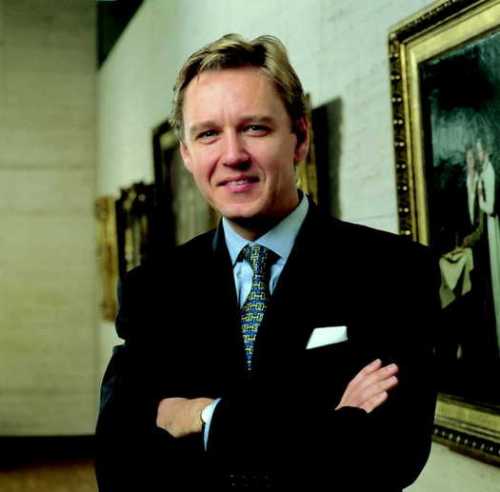On Feb 14th, Getty CEO James Cuno announced to staff that Timothy Potts had been named as the new director of the Getty Museum, the wealthiest art museum in the world. He will start in September.
Potts comes with an impressive provenance. He was trained as an archaeologist at the University of Sydney and Oxford, where he received his doctorate in Near Eastern art and archeaology. He dug for several years at Pella in Jordan, where he was co-director. And after a stint at Lehman Brothers, Potts directed the National Gallery of Victoria (1994 – 1998), the Kimbell Art Museum in Ft. Worth Texas (1998 – 2007) and most recently the Fitzwilliam Museum in Cambridge.
Despite his background in field archaeology, Potts has more recently held some controversial views on the collecting of unprovenanced antiquities. Here’s a quick cheat sheet:
 As director of the Kimbell, Potts helps build the antiquities collection of the Ft. Worth museum, which has an acquisition budget on par with the Getty Museum. Among his acquisitions are some with questionable provenance, such as this Greek cup by the Douris Painter, which the Kimbell bought in 2000. The cup can be traced back to 1977 and Elie Borowski, an antiquities dealer (now deceased) known have trafficked in recently looted objects.
As director of the Kimbell, Potts helps build the antiquities collection of the Ft. Worth museum, which has an acquisition budget on par with the Getty Museum. Among his acquisitions are some with questionable provenance, such as this Greek cup by the Douris Painter, which the Kimbell bought in 2000. The cup can be traced back to 1977 and Elie Borowski, an antiquities dealer (now deceased) known have trafficked in recently looted objects.
In 2003, Potts was outspoken about the looting in Iraq. He appeared on Charlie Rose Show with Philippe de Montebello here.
In 2004, Potts was a key player in the deliberations over the AAMD’s revised antiquities collecting policies, which you can find here. The policy allowed museums to collect unprovenanced (and likely looted) antiquities if they had documentation going back 10 years. It was a controversial position that would be modified a few years later amidst the antiquities scandal we write about in Chasing Aphrodite.
In 2006, Potts chaired a taskforce for the AAMD that devised new guidelines for accepting loans of antiquities. The policy stated:
Archaeological material and works of ancient art for which provenance information is incomplete or unobtainable may deserve to be publicly displayed, conserved, studied, and published because of their rarity, historical importance and aesthetic merit…
Many saw it as a loophole that allowed museums to continue displaying looted antiquities. Potts defended the policy in an interview with the New York Times:
“If [the ancient art] goes on view with other like objects, then scholars get to see it and study it; the public gets to come; the claimant, if there is one, gets to know where it is and file a claim,” said Timothy Potts, the director of the Kimbell Art Museum in Fort Worth and the chairman of the task force that drew up the guidelines. “Who has lost in this process?” Some museum directors argue that the current wave of antiquities claims against museums and collectors actually resulted from active efforts by museums to display the works and publish articles about them.
…
For Mr. Potts, an archaeologist by training, the recent attention to the role of collectors and museums in fostering the destruction of archaeological sites is misplaced. The real issue, he argued, is insufficient incentives in countries like Italy and Greece for discoverers of objects to report their finds.
“So much of the pressure is focusing on the wrong end of the chain,” he said. “I think there should be much more done to stop the looting at its source.”
Later that year, Potts and Cuno organized a public symposium to address the controversy over museums and the illicit antiquities trade. Many of the leading voices in the heated debate participated. The goal was “to explore how museums have, and can responsibly continue to, protect, interpret and exhibit archaeological material and works of ancient art.”
May 2007: Potts was interviewed on NPR about looting and the illicit antiquities trade. He said:
“There were empires, there was war, there was booty taken. To the victor went the spoils, and the museums of the world still represent the dispositions of some of those historical events. We are now living in this different world, and we are requiring more provenance history, and if we think it was recently excavated, we’re just not going to buy it.”
In Jan 2010, Potts gave a tour of the renovated antiquities galleries at the Fitzwilliam Museum in Cambridge. Video and story here.
Dr Potts said: “The Fitzwilliam’s collection of Greek and Roman antiquities is of international significance, so I’m delighted that we now have a superbly redesigned space in which to display it to its full potential.
“This new presentation, which is based on recent research and conservation work, will offer many fresh insights, not only to new visitors, but also to those familiar with the collection.”

In Feb 2010, Potts and de Montebello were among several experts who advised the Leon Levy Foundation about an effort to publish “the trove of unpublished information from important ancient world sites excavated under ‘partage’ agreements.”
Given their pro-collecting positions in a museum world that has largely turned in a different direction, it will be interesting to see how Cuno and Potts decide to deploy the Getty’s wealth in the coming years.




More about the Kimbell Art Museum: http://www.museum-security.org/03/009.html
Pingback: Former Kimbell Director Now Getty Museum Director | Art&Seek | Arts, Music, Culture for North Texas
Pingback: Chasing Aphrodite 2012: The Year in Review | CHASING APHRODITE
L’ha ribloggato su Pittura1arte2disegno3e ha commentato:
WIKILOOT,caccia alle antichità saccheggiate nei Musei del Mondo